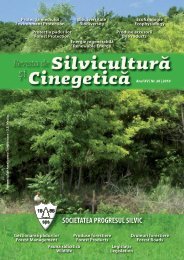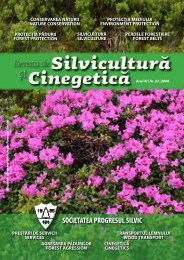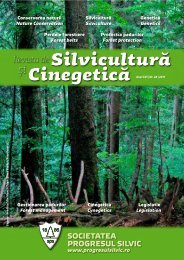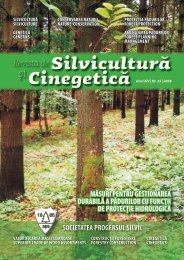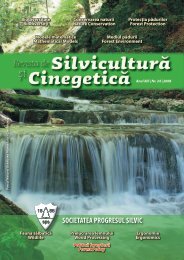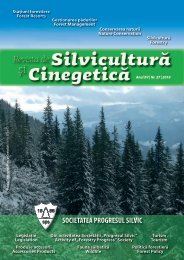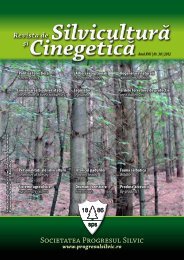Silviculture and Cinegetics Review - Societatea Progresul Silvic
Silviculture and Cinegetics Review - Societatea Progresul Silvic
Silviculture and Cinegetics Review - Societatea Progresul Silvic
Create successful ePaper yourself
Turn your PDF publications into a flip-book with our unique Google optimized e-Paper software.
FORESTRY BELTS SILVICULTURE AND CINEGETICS REVIEW XVII/30/2012<br />
Implementation <strong>and</strong> expansion of these combined<br />
systems of agriculture <strong>and</strong> forestry, in addition to the<br />
role of mitigation <strong>and</strong> balancing of extreme climatic<br />
factors, will surely bring undeniable economic <strong>and</strong><br />
social benefits by increasing productivity of grassl<strong>and</strong>s<br />
<strong>and</strong> animals, plus additional capitalization for different<br />
purposes of the woody vegetation scarce in the plain<br />
<strong>and</strong> hills areas. The agroforestry system contributes to<br />
combat of soil erosion <strong>and</strong> l<strong>and</strong>slides on the slopes,<br />
increasing the potential for carbon fixation per unit area<br />
<strong>and</strong> last but not least the beautification <strong>and</strong><br />
attractiveness of existing l<strong>and</strong>scapes.<br />
1.Forecasts of Climate Change<br />
1.1.Climate change <strong>and</strong> its consequences in<br />
Romania<br />
From the data from WMO (World Meteorological<br />
Organization) in Geneva, the average world temperature<br />
has risen between 1901 <strong>and</strong> 2000 by 0.6 0 C which is<br />
extremely high. For Romania, per INMH – Bucharest,<br />
this increase is of 0.3 0 C, higher in the south <strong>and</strong> east<br />
regions (0.8 0 C) <strong>and</strong> lower in the intra-Carpathian<br />
regions (0.1 0 C). Global warming was more<br />
pronounced after 1961 <strong>and</strong> especially after 2000 (2003,<br />
2005) when the frequency of tropical days (daily<br />
maximum > 30 0 C) increased alarmingly <strong>and</strong> the<br />
winter days (daily maximum < 0 0 C) decreased<br />
substantially. As a result many areas of our country are<br />
at high risk of drought <strong>and</strong> desertification in particular<br />
where the average annual temperature is above 10 0 C;<br />
the amount of annual rainfall is less than 350 – 550 mm;<br />
rainfall from April to October are under 200 – 350 mm<br />
<strong>and</strong> soil water reserves 0 – 100 cm on March 31 is less<br />
than 950 –1500 mc /ha.<br />
According to the United Nations Convention to Combat<br />
Desertification (UNCDD) the aridity index (annual<br />
amount of precipitation/ potential evapotranspiration–<br />
ETP) for arid areas, deserts is of 0,05 <strong>and</strong> 0,65 for dry<br />
sub-humid areas, the threshold above which a territory<br />
is considered to be close to normal. Under this<br />
agreement, ETP for steppe <strong>and</strong> forest steppe is of 400 –<br />
900 mm <strong>and</strong> for the mountain area is of 300 mm of<br />
water.<br />
In the fourth report (2007) of International Committee<br />
on Climate Change (ICCC) for 2020 – 2030 compared<br />
to 2000 in an optimistic variant it is expected an<br />
increase of the average global temperature by 0.5 0 C<br />
<strong>and</strong> in a more pessimistic one, by 1.5 0 C <strong>and</strong> in the<br />
period 2030 – 2100 the increase of the two variants<br />
ranges between 2.0 0 C <strong>and</strong> 5.0 0 C, which is extremely<br />
high. If we take the year 2070 with an increase of only 3<br />
0 C above current levels, than 68 % of Romanian<br />
territory below 500 m altitude will be subject to aridity<br />
<strong>and</strong> desertification, namely an area more than double<br />
the current mountain area (Table 1).<br />
Table 1. Percentage altitudinal distribution of the forms of<br />
relief on the Romanian territory (by ROMANIAN<br />
GEOGRAPHY vol.I, 1983)<br />
Altitudes<br />
(m)<br />
% of<br />
Romanian<br />
territory<br />
(237,5 K<br />
km 2 )<br />
Moun<br />
tains<br />
Of which:<br />
Hills<br />
Plai<br />
ns<br />
above 2000 1 3<br />
1500 - 2000 3 7<br />
1000 - 1500 6 19<br />
700 - 1000 12 36 3<br />
500 - 700 10 16 12<br />
300 - 500 18 12 38 1<br />
200 - 500 12 7 24 5<br />
100 - 200 18 18 35<br />
0 - 100 20 5 59<br />
Above 500 32 81 15<br />
m<br />
Under 500 68 19 85 100<br />
m *)<br />
*) territory affected by aridity <strong>and</strong> desertification in the case of an<br />
increase of average air temperature by 3 0 C, forecast until 2070.<br />
With the increase by 3 0 C of the air average<br />
temperature on the Romanian territory is expected that<br />
Dobrogea, the South of Moldova, the West of Ardeal,<br />
Banat, the South of Oltenia <strong>and</strong> a good part of the South<br />
of Romanian Plain, that is over 30 % of the country will<br />
undergo a process of desertification <strong>and</strong> the rest of<br />
approx. 38 % a process of advanced aridity, which will<br />
further include all our plains, up to 85 % of the surface<br />
of the hills <strong>and</strong> almost 20 % of the mountains of lower<br />
altitudes.<br />
1.2. Forecast of bioclimatic changes<br />
Forecasted climate changes will have a major impact on<br />
redistribution of current vegetation by zones <strong>and</strong><br />
altitudinal floors, which in their turn will have an<br />
impact on habitats <strong>and</strong> economic performance. Based<br />
on the projections for the years 2070 an increase by 3 0 C<br />
of the average air temperature in the mountain area by<br />
the current altitudinal gradients (-0.5 0 C / 100 m alt.) is<br />
74



